Srijan Class-9 Flower ICSE Biology Solutions Ch-3. We Provide Solutions of Concept Check-1 and 2 ,Very Short Ans, Short Ans, Long Ans, Multiple Choice Type (including True False), Application /Skill (Figure Based ) Questions by expert teachers as per ICSE board guidelines. Visit official Website CISCE for detail information about ICSE Board Class-9.
| Board | ICSE |
| Publications | Srijan Publication |
| Subject | Biology |
| Class | 10th |
| writer | Veer Bala Rastogi |
| Book Name | …………. |
| Topics | Solutions of Concept Check-1 , 2 ,Very Short Ans, Short Ans, Long Ans, MCQ, Application Skill Based Questions |
| Edition | 2021-2022 |
Srijan Class-9 Flower ICSE Biology Solutions Ch-3
–: Included Topics :–
Concept Check 1
Concept Check 2
A. VERY SHORT ANSWER TYPE,
B .SHORT ANSWER TYPE,
C .LONG ANSWER TYPE,
D. MULTIPLE CHOICE TYPE,
E. Application/Skill-based Questions
Concept Check 1 (Page 41)
State whether the the following statements are true or false :
Question-1
A typical flower has four whorl
Answer-1
True
Question-2
The calyx and corolla are non reproductive whorls of a flower .
Answer-2
True
Question-3
A bract is a leaf like structure that arises in the axil of a flower.
Answer-3
True
Question -4
In bougainvillea , bracts are larger4 and green.
Answer-4
True
Question-5
Sepals and petals are absent in neuter flowers.
Answer-5
False
Question-6
In polypetalous corolla , the petals are united.
Answer-6
True
Flower ICSE 9th Solutions Srijan Publishers
Concept Check 2 (Page 43)
State whether the the following statements are true or false. If false, write the correct statements by changing the incorrect word/words only.
Question:1
Inflorescence is the arrangement of the ovaries on the flower.
Answer :1
False
Question:2
Ovules are attached to placenta in ovary.
Answer :2
True
Question:3
Essential parts of a flower include stamens and carpels.
Answer :3
True
Question:4
Androecium consist of male reproductive organs called stamens.
Answer :4
True
Question:5
In diadelphous condition ,filaments of stamens are united into two bundles and the others remain free.
Answer :5
True
Flower ICSE 9th Solutions Srijan Publishers
A. VERY SHORT ANSWER TYPE, (Page 43)
Question 1:
Give one word for the following:
(a) Flower containing all the four whorls.
(b) Filament are united to form a single staminal tube
(c) Axis bearing a group of flowers.
(d) Sepals and petals of the same colure.
(e) A pistil having a large number of carpels.
Answer :
(a) Complete flower
(b) Monadelphous stamens
(c) Raceme
(d) No
(e) Syncarps
Question 2:
(a) A flower …………….
(b) A pistil …………….
(c) A unisexual flower ………………
(d) Small leafy …………………
(e) Fused anther ……………..
Answer :
(a) Bisexual flower
(b) Bicarpellary
(c) Staminate flower
(d) Receptacle
(e) Monadelphous Stamens
Flower ICSE 9th Solutions Srijan Publishers
B. Short Answer Type Questions, (Page 44)
Question 1:
Define the following terms :
(a) Apocarps gynoecium
(b) Monocarpellary ovary
(c)Syncarps gynoecium
(d) Placentation
Answer :
(a) Apocarps gynoecium
Apocarpous gynoecium means the presence of more than one carpel and the carpels are separate or unfused. It is a primitive condition. The examples of Apocarpous gynoecium include -Strawberry and Buttercup.
(b) Monocarpellary ovary
Monocarpellary Superior Ovary” means ovary with one carpel with the floral parts arrranged on the thalamus below the ovary
(c) Syncarps gynoecium
If a gynoecium has multiple carpels “fused” into a single structure, it is syncarpous. … In a syncarpous gynoecium, the “fused” ovaries of the constituent carpels may be referred to collectively as a single compound ovary. It can be a challenge to determine how many carpels fused to form a syncarpous gynoecium.
(d) Placentation
Placentation is defined as the arrangement of the placenta or placentae in the ovary of a flower. Six type of placentation were observed in plants
Question 2:
Distinguish between the following
(a) Bract and perianth
(b) Polypetalous and gamopetalous corolla
(c) Flower and inflorescence
Answer :
(a) Bract and perianth
As nouns the difference between bract and perianth is that bract is (botany) a leaf or leaf-like structure from the axil out of which a stalk of a flower or an inflorescence arises while perianth is (botany) the sterile parts of a flower; collectively, the sepals and petals (or tepals)
(b) Polypetalous and gamopetalous corolla
the difference between polypetalous and gamopetalous. is that polypetalous is (botany) having a corolla composed of distinct, separable petals while gamopetalous is (botany) having petals wholly or partially fused such that the corolla takes the form of a tube
(c) Flower and inflorescence
The difference between flower and inflorescence are given below. It is the seed bearing part of a plant comprising petals, sepals, stamens and carpels. It is the complete flower head of a plant consisting of stems, bracts, stalks and flowers. … In inflorescence, the stalk is known as peduncle.
Question 3:
Where are the following structures located and what are their functions?
(a) Thalamus
(b) Stigma
(c) Anther
(d) Placenta
Answer :
(a) Thalamus
(b) Stigma
(c) Anther
(d) Placenta
| Name of the structure | Location | Function | |
| d. | Placenta | Swollen area or cushion in the ovary | Renders origination to the ovules |
| a. | Thalamus | Tip of the stalk of the flower | Bears all the flower parts |
| c. | Anther | Section of the stamen | Production of pollen grains |
| b. | Stigma | Knob-like structure at the terminal end of style | During pollination, provides landing site for the pollen grains |
Flower ICSE 9th Solutions Srijan Publishers
C .LONG ANSWER TYPE, (Page 44)
Question 1 :
What is a flower? What are different parts of a typical flower ?
Answer :
A typical flower has four main parts—or whorls—known as
the calyx,
corolla,
androecium,
and gynoecium .
The outermost whorl of the flower has green, leafy structures known as sepals. The sepals, collectively called the calyx, help to protect the unopened bud.
The second whorl is comprised of petals—usually, brightly colored—collectively called the corolla.
Together, the calyx and corolla are known as the perianth.
The third whorl contains the male reproductive structures and is known as the androecium. The androecium has stamens with anthers that contain the microsporangia.
The innermost group of structures in the flower is the gynoecium, or the female reproductive component(s). The carpel is the individual unit of the gynoecium and has a stigma, style, and ovary. A flower may have one or multiple carpels.
Question 2 :
What are different types of flowers based op shape and symmetry? Describe with examples.
Answer :
Unisexual flowers are either staminate (bearing stamens only) or pistillate (bearing pistils only) and are said to be imperfect.
Bisexual flowers are perfect because they have both stamens and pistil.
When staminate and pistillate flowers occur on the same individual, the plant is called monoecious (examples include corn and the walnut tree).
When staminate and pistillate types of flowers are borne on separate individual flowers, the plant is said to be dioecious (examples include asparagus and willow).
Question 3 :
What is calyx? List its various functions.
Answer :
The main function of the calyx is to protect the flower in its bud condition. The calyxes are usually green in colour but sometimes it may be coloured as petalloid, then it can attract insect and helps in pollination. In certain cases calyx develop spur and can store nectar or sometime it helps in seed dispersal too
Question 4 :
What do you mean by cohesion of stamens? Describe different types of stamens on the basis of cohesion of stamens.
Answer :
The union of stamens when takes place among themselves is called as cohesion. The fusion of stamens with each other is called cohesion of stamens. Three main types of stamen fusion are identified: filament fusion, anther fusion, and fusion with both filament and anther.
Flower ICSE 9th Solutions Srijan Publishers
D. MULTIPLE CHOICE TYPE, (Page 44)
Choose the correct answer.
Question 1 :
In a typical complete, bisexual flower the arrangement of floral whorls on the thalamus from the outermost to the innermost is
(a) Calyx, Corolla, Androecium and Gynoecium
(b) Calyx, Corolla, Gynoecium and Androecia
(c) Gynoecium, Androecium, Corolla and Calyx
(d) Androecium, Gynoecium, Corolla and Calyx
Answer :
(a) Calyx, Corolla, Androecium and Gynoecium
Question 2 :
Bougainvillea flower
(a) is a complete flower
(b) is an incomplete flower
(c) has a large nectary
(d) has large colourful bracts
Answer :
(d) has large colourful bracts
Flower ICSE 9th Solutions Srijan Publishers
E. Application/Skill-based Questions (Page 44)
Question 1:
The given diagram shows the vertical section of a flower.
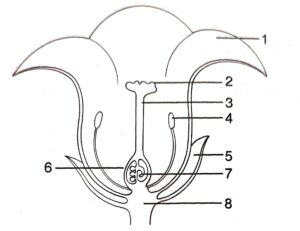
(a) Name the parts numbered 1 to 8.
(b) What are the functions of parts 2 to 4?
(c) Which part of the flower forms the fruit?
(d) Is the flower shown here unisexual or bisexual?
Question 2:
Given below are two figures (A and B) of a certain part of a flower. Study the figures carefully and answer the following questions:
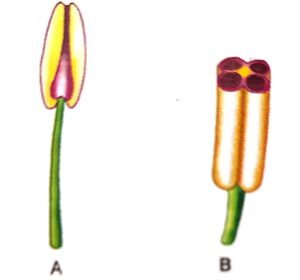
(a) Which organ does the figure A represent? What is the collective name of this organ?
b) Name the contents of structure shown in figure B. Is this male or female ?
(c) How do the contents of structure shown in figure B come out ?
Answer 1 & 2 :
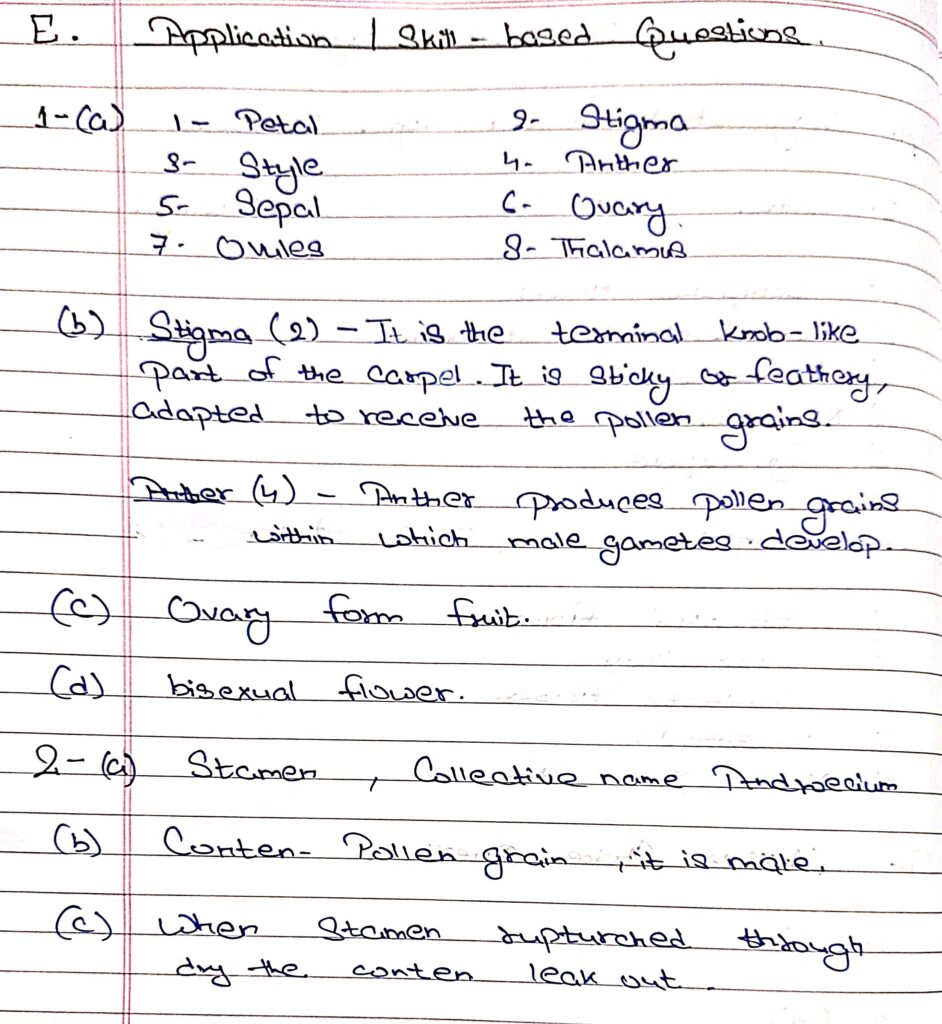
Return to :- Srijan Publication ICSE Biology Class-9
Thanks
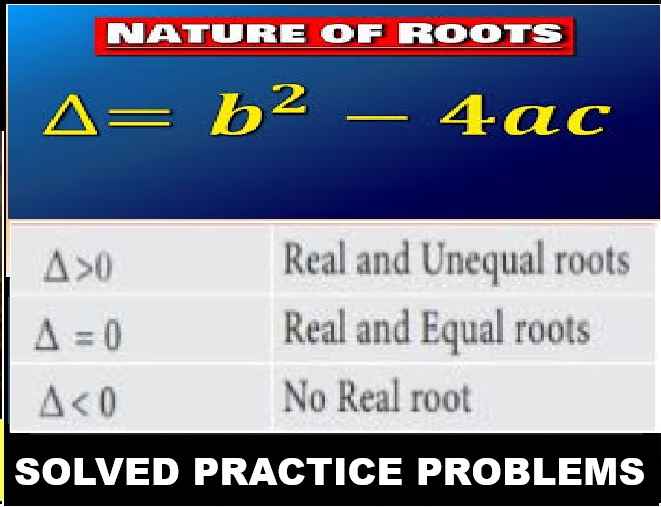
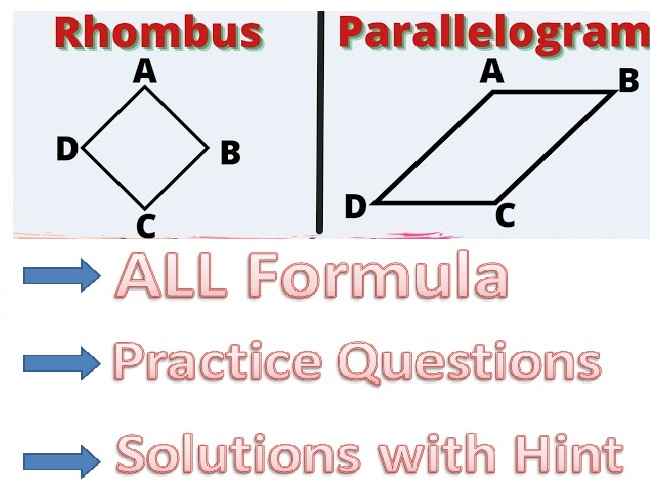

Some answers are wrong but it’s good 😂😊
if wrong update soon
Not very good not very bad average but I want wrong answer should be correct 💯
whatsapp your latest resume on 8948221203 if interested
average but I want wrong answer should be correct 💯